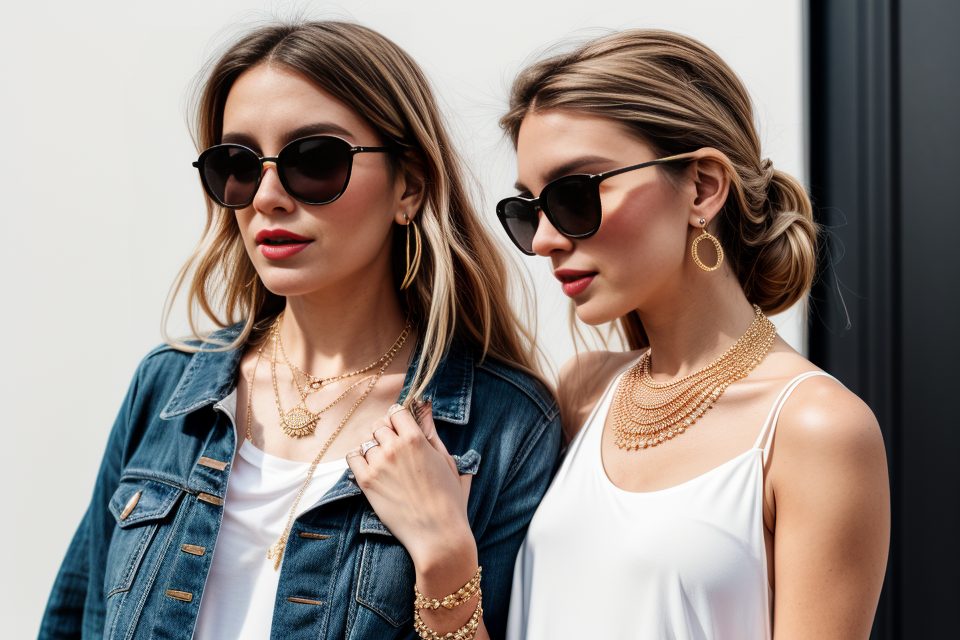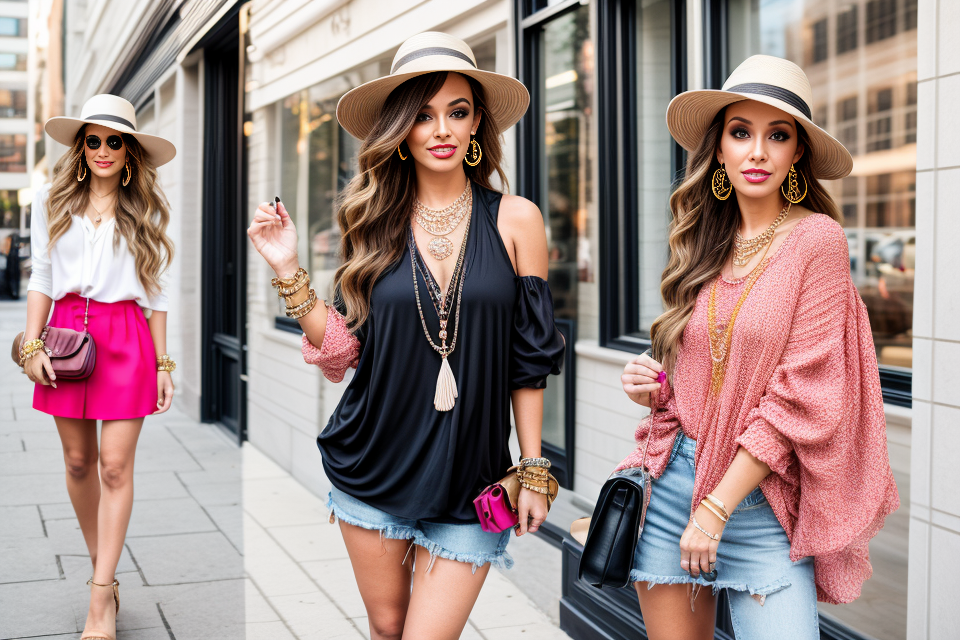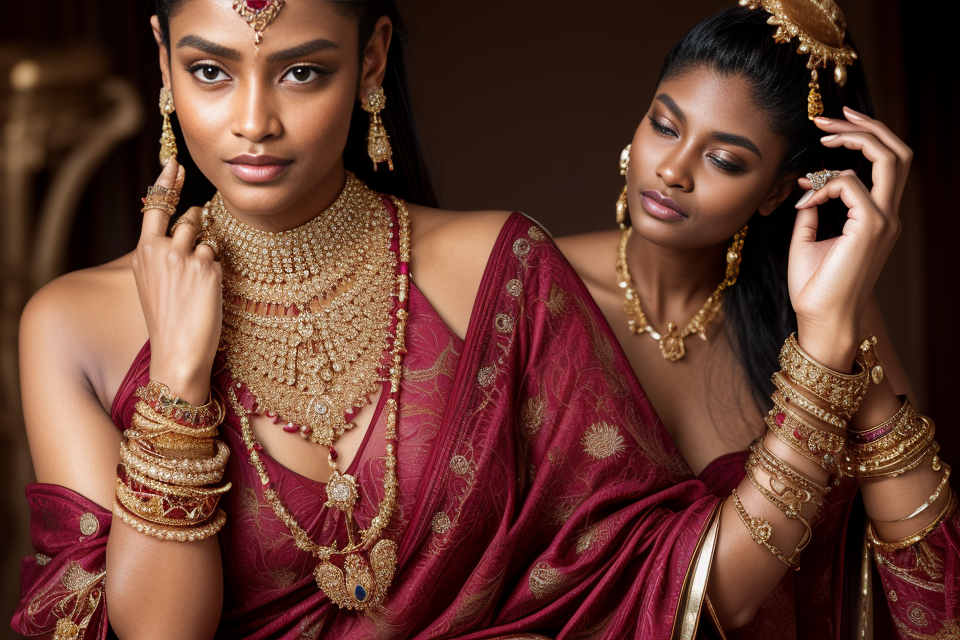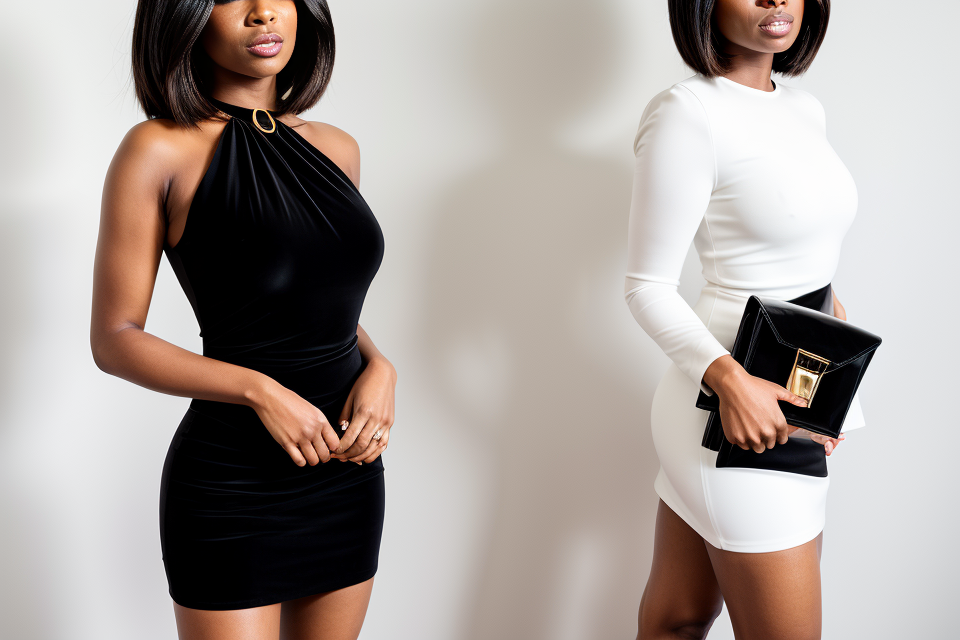
Accessorizing your outfit can be a daunting task. With so many options available, it can be hard to know where to start. But fear not, because this comprehensive guide will help you navigate the world of accessories and discover what pieces will complement your personal style. From necklaces to earrings, hats to belts, we’ll cover it all. By the end of this guide, you’ll have a better understanding of how to put together a cohesive look that is both stylish and practical. So, let’s dive in and explore the world of accessories!
When it comes to accessorizing your outfit, the options can be overwhelming. However, a few key pieces can really elevate your look. A classic watch is always a great option, as it adds a touch of sophistication to any outfit. A statement necklace can also make a big impact, whether you choose a delicate chain or a bold, chunky piece. For a more minimalist look, a simple pair of stud earrings can do the trick. And don’t forget about the power of a good handbag – a stylish tote or clutch can really tie an outfit together. When it comes to accessorizing, the key is to keep it simple and let your outfit be the star of the show.
How to Determine Your Personal Style
Factors Affecting Personal Style
Body shape and size
One of the primary factors that affect personal style is body shape and size. It is essential to understand the proportions of your body and how to accentuate your features. For instance, if you have a broader upper body, you may want to wear more fitted clothing to balance out your silhouette. On the other hand, if you have a smaller lower body, you can wear pants that are slightly flared or wide-legged to create the illusion of longer legs.
Occupation and lifestyle
Your occupation and lifestyle also play a significant role in determining your personal style. For example, if you work in a formal office setting, you may want to prioritize a more conservative and professional wardrobe. However, if you lead a more casual lifestyle, you may opt for a more relaxed and comfortable style. Consider the level of formality required in your workplace and choose accessories that complement your work attire.
Climate and season
Climate and season are crucial factors to consider when determining your personal style. The type of weather and climate you live in will impact the type of clothing and accessories you choose. For instance, if you live in a cold climate, you may prioritize warm and practical accessories such as scarves, gloves, and hats. On the other hand, if you live in a warmer climate, you may opt for lightweight and breathable fabrics that are easy to wear.
Personal preferences and taste
Personal preferences and taste are the most subjective factors that affect personal style. It is essential to consider what you like and dislike when choosing accessories. For example, if you prefer bold and vibrant colors, you may want to choose accessories that complement your preferred color palette. Similarly, if you have a particular material or texture that you enjoy, you can incorporate it into your accessory choices. Ultimately, your personal style should reflect your unique preferences and make you feel confident and comfortable.
Identifying Your Personal Style
When it comes to identifying your personal style, there are several key steps you can take to ensure that you end up with a wardrobe that truly reflects your unique personality and taste.
First and foremost, it’s important to experiment with different styles. This means trying out different clothing items, accessories, and even hairstyles to see what works best for you. By trying on a variety of different options, you’ll be able to get a better sense of what flatters your body shape and size, as well as what kind of style makes you feel most confident and comfortable.
In addition to experimenting with different styles, it’s also important to take note of what flatters your body shape and size. Everyone has different body types, and what looks good on one person may not necessarily work for another. By paying attention to what flatters your figure, you’ll be able to make more informed decisions about what to wear and what accessories to choose.
Another important factor to consider when identifying your personal style is your occupation and lifestyle. For example, if you work in a more formal office environment, your style may need to be more conservative and professional. On the other hand, if you lead a more casual lifestyle, you may feel more comfortable in more relaxed, comfortable clothing.
Finally, it’s important to reflect on your preferences and taste. What kind of clothes and accessories do you feel most comfortable wearing? What colors and styles do you find most appealing? By considering your personal preferences and taste, you’ll be able to create a wardrobe that truly reflects who you are and makes you feel your best.
Choosing the Right Accessories for Your Outfit
Matching Necklaces and Earrings
When it comes to accessorizing your outfit, matching your necklace and earrings is an essential part of creating a cohesive and stylish look. Here are some tips to help you match your necklaces and earrings perfectly:
- Match metals and colors: The first step in matching your necklace and earrings is to ensure that the metals and colors complement each other. For example, if you’re wearing gold jewelry, you could pair it with silver or white gold earrings. Similarly, if you’re wearing silver jewelry, you could pair it with gold or rose gold earrings. When it comes to colors, you should try to match the colors of your necklace and earrings as closely as possible.
- Avoid clashing or conflicting styles: While it’s important to match your necklace and earrings, it’s also important to avoid clashing or conflicting styles. For example, if your necklace has a bold and statement-making design, you should pair it with simpler earrings that don’t compete with it. Similarly, if your earrings have a statement-making design, you should pair them with simpler necklaces that don’t compete with them.
- Coordinate sizes and shapes: Finally, you should try to coordinate the sizes and shapes of your necklace and earrings. For example, if you’re wearing a large and statement-making necklace, you should pair it with smaller and more delicate earrings. Similarly, if you’re wearing small and delicate earrings, you should pair them with larger and more statement-making necklaces.
By following these tips, you can ensure that your necklace and earrings match perfectly and create a cohesive and stylish look.
Layering Jewelry
When it comes to jewelry, layering is a great way to add depth and dimension to your outfit. It can be as simple or as elaborate as you want, depending on your personal style and the occasion. Here are some tips on how to layer your jewelry like a pro:
- Start with a simple piece: Begin by choosing a simple piece of jewelry, such as a necklace or bracelet, to serve as the base of your layered look. This will provide a subtle touch of elegance to your outfit without overwhelming it.
- Add one or two more accessories: Once you have your base piece, you can add one or two more accessories to your layered look. This could be a pair of earrings, a ring, or even a pair of hoop earrings. Make sure the additional pieces complement the base piece and don’t clash with each other.
- Balance delicate and statement pieces: When layering jewelry, it’s important to balance delicate pieces with statement pieces. Delicate pieces, such as thin necklaces or small earrings, can be worn alongside larger, more bold statement pieces to create a cohesive and stylish look.
Remember, layering jewelry is all about creating a harmonious look that complements your outfit and personal style. With these tips, you can easily achieve a chic and sophisticated layered jewelry look.
Mixing and Matching Accessories
When it comes to accessorizing your outfit, mixing and matching different pieces can be a great way to add depth and dimension to your look. However, it’s important to do so in a way that complements your outfit and doesn’t overwhelm it. Here are some tips for mixing and matching accessories:
- Consider color, texture, and pattern: When choosing accessories, think about how they will work with the colors, textures, and patterns of your outfit. For example, if you’re wearing a patterned dress, you might want to choose accessories that have a similar color scheme or texture to create a cohesive look.
- Create a cohesive look: While it’s important to mix and match different accessories, it’s also important to make sure that they work together to create a cohesive look. For example, if you’re wearing a statement necklace, you might want to choose simpler earrings that don’t compete with it.
- Avoid overwhelming your outfit: When choosing accessories, it’s important to make sure that they don’t overwhelm your outfit. For example, if you’re wearing a delicate dress, you might want to choose simple accessories that don’t detract from the dress. Additionally, be mindful of the size and weight of your accessories, as they can affect the overall balance of your outfit.
Using Accessories to Enhance Your Outfit
Adding the right accessories to your outfit can make all the difference in how you look and feel. Here are some ways accessories can enhance your outfit:
- Highlight your best features: Certain accessories can draw attention to your best features, such as a statement necklace that highlights your collarbone or a pair of sunglasses that accentuate your eyes.
- Add interest to a basic outfit: If you’re wearing a simple outfit, accessories can add visual interest and dimension to your look. For example, a bold bracelet or a patterned scarf can add pop to a plain t-shirt and jeans.
- Complete a look: Sometimes, an outfit can feel incomplete without the right accessory. Accessories can help tie a look together and make it feel more cohesive. For example, a belt can cinch in a loose dress or a pair of earrings can add the finishing touch to a bold lip and dramatic eye makeup.
It’s important to remember that accessories should never overpower your outfit, but rather complement it. By choosing the right accessories, you can elevate your look and make it feel more polished and put-together.
Choosing the Right Accessories for Different Occasions
When it comes to choosing the right accessories for your outfit, it’s important to consider the occasion. Different occasions call for different styles and levels of formality, and your accessories should reflect this. Here are some guidelines to help you choose the right accessories for different occasions:
- Formal vs. casual events: For formal events, such as weddings or black-tie galas, you’ll want to choose accessories that are sophisticated and elegant. This might include diamond stud earrings, a silver cuff bracelet, or a delicate pendant necklace. For casual events, such as a day at the beach or a picnic in the park, you can opt for more playful and colorful accessories, like a bold statement necklace or a pair of bright sunglasses.
- Work vs. play: When it comes to work, it’s important to choose accessories that are professional and appropriate for the office. This might include a classic watch, a simple pendant necklace, or a pair of stud earrings. For play, you can get more creative with your accessories, opting for statement pieces like a bold necklace or a pair of colorful earrings.
- Day vs. night: For daytime events, you’ll want to choose accessories that are light and airy, like delicate chain necklaces or stud earrings. For nighttime events, you can opt for bolder, more dramatic pieces, like statement necklaces or dangly earrings. Additionally, you may want to consider adding a pop of color to your outfit with a bright clutch or heels.
Shopping for Accessories
When it comes to shopping for accessories, there are a few key things to keep in mind to ensure that you are getting the most out of your purchases. Here are some tips to help you make the most of your accessory shopping trips:
- Determine your budget: Before you start shopping, it’s important to have a clear idea of how much you are willing to spend on accessories. This will help you to narrow down your options and avoid overspending.
- Shop for quality over quantity: While it can be tempting to buy as many accessories as possible, it’s important to remember that quality is key. Investing in a few high-quality pieces that will last you a long time is always a better choice than buying a lot of cheap, poorly made accessories that will quickly fall apart.
- Look for versatile pieces: When shopping for accessories, it’s important to look for pieces that you can wear in a variety of settings and with a variety of outfits. This will help you to get the most out of your purchases and ensure that you are getting the most value for your money.
Storing and Caring for Your Accessories
Proper storage and care are essential to ensure that your accessories remain in good condition and continue to complement your outfits. Here are some tips to help you store and care for your accessories:
Organize your collection
To keep track of your accessories and make it easier to find the ones you need, it’s important to organize your collection. Consider investing in storage boxes or organizers that are specifically designed for jewelry or other types of accessories. You can also use drawer dividers or hanging organizers to keep your accessories neat and tidy.
Store properly to prevent damage
Different accessories require different storage methods to prevent damage. For example, necklaces and bracelets can be stored on hooks or in boxes, while earrings should be stored in cases to prevent them from getting tangled or damaged. It’s also important to store your accessories in a dry, dark place to prevent tarnishing or other types of damage.
Clean and maintain your accessories
Regular cleaning and maintenance are essential to keep your accessories looking their best. For example, you can use a soft cloth to wipe away dust or dirt from your jewelry, and you can use a mild soap and water solution to clean your sunglasses or other types of accessories. It’s also a good idea to have your accessories professionally cleaned and checked for any damage on a regular basis.
By following these tips, you can ensure that your accessories remain in good condition and continue to complement your outfits for years to come.
Incorporating Accessories into Your Wardrobe
Building Your Accessory Collection
When it comes to building your accessory collection, there are a few key things to keep in mind. First and foremost, it’s important to start with the basics. This means investing in timeless pieces that will never go out of style, such as a classic watch, a simple necklace, or a pair of stud earrings. These types of accessories can be worn with a variety of outfits, making them a valuable addition to any wardrobe.
Once you have the basics covered, you can start to add statement pieces to your collection. These are accessories that make a bold statement and add visual interest to an outfit. Examples of statement pieces include large hoop earrings, bold bracelets, and brightly colored handbags. These types of accessories can be used to add a pop of color or make a statement in an outfit.
Another important aspect of building your accessory collection is investing in quality over trendy items. While it may be tempting to buy the latest trendy accessory, it’s important to remember that these types of accessories often go out of style quickly. Instead, focus on investing in high-quality accessories that will last for years to come. This means looking for accessories made from high-quality materials, such as gold or silver, and avoiding trendy materials that may not hold up over time.
By following these tips, you can build a comprehensive accessory collection that will elevate any outfit and help you express your personal style.
Experimenting with Different Styles
When it comes to experimenting with different styles, the possibilities are endless. You can try new combinations, experiment with different colors and patterns, and have fun with accessories. Here are some tips to help you get started:
- Try new combinations: Don’t be afraid to mix and match different accessories. You can pair a bold necklace with a simple dress, or add a pop of color with a patterned scarf. The key is to have fun and not be afraid to try new things.
- Experiment with different colors and patterns: Different colors and patterns can greatly affect the overall look of an outfit. For example, pairing a striped shirt with a polka dot scarf can create a playful and unique look. Experiment with different combinations to find what works best for you.
- Have fun with accessories: Accessories are a great way to add personality to your outfits. Don’t be afraid to add a statement piece, such as a bold bracelet or colorful earrings. The goal is to have fun and express your personal style.
Remember, the key to experimenting with different styles is to have fun and not be afraid to try new things. Don’t be afraid to mix and match different accessories, experiment with different colors and patterns, and have fun with accessories. With a little creativity, you can create unique and stylish outfits that reflect your personal style.
Making a Statement with Accessories
Adding statement accessories to your outfit can elevate your look and make you stand out from the crowd. Whether you prefer bold and bright pieces or more subtle and sophisticated options, there are plenty of ways to make a statement with accessories. Here are some tips to help you do just that:
- Add pops of color: One way to make a statement with accessories is by adding pops of color to your outfit. This can be as simple as wearing a brightly colored handbag or pair of shoes, or as bold as adding a statement necklace in a bold hue. This is a great way to add interest to a monochromatic outfit or to complement a colorful piece.
- Make a bold statement: Another way to make a statement with accessories is by choosing bold and unique pieces. This can include oversized earrings, chunky necklaces, or statement bracelets. These types of accessories can add drama to any outfit and are sure to turn heads.
- Accessorize with confidence: When it comes to making a statement with accessories, it’s important to have confidence in your choices. Don’t be afraid to try new things and experiment with different styles. Remember that accessories are meant to be fun and should reflect your personal style. So, go ahead and make a statement with your accessories!
FAQs
1. What is the first step in determining what accessories to wear?
The first step in determining what accessories to wear is to consider the occasion and the dress code. Different occasions call for different types of accessories, such as formal wear for a wedding or casual wear for a day out with friends. Additionally, the dress code can provide guidance on what types of accessories are appropriate, such as no jewelry for a beach wedding or statement jewelry for a formal event.
2. How should I consider my personal style when choosing accessories?
Your personal style is an important factor to consider when choosing accessories. Think about the types of accessories that complement your personal style and the types of accessories that you feel most comfortable wearing. Consider the colors, materials, and shapes that flatter your body type and facial features. For example, if you have a round face, you may want to avoid wearing large hoop earrings and instead opt for smaller studs.
3. How many accessories should I wear at once?
The number of accessories you wear at once depends on the occasion and your personal style. As a general rule, it’s best to keep the number of accessories to a minimum to avoid overwhelming your outfit. For a more formal occasion, such as a wedding, you may want to stick to wearing just one statement piece, such as a necklace or pair of earrings. For a more casual occasion, such as a day out with friends, you may feel more comfortable wearing multiple smaller accessories, such as a bracelet and a pair of stud earrings.
4. What types of accessories are appropriate for different body types?
Different body types can look good in different types of accessories. For example, a person with a petite frame may want to avoid wearing large, bulky accessories that can overwhelm their small frame. Instead, they may want to opt for smaller, dainty accessories that complement their frame. On the other hand, a person with a tall frame may want to wear statement accessories that draw attention to their height and balance out their frame.
5. How can I mix and match my accessories?
Mixing and matching your accessories can be a fun way to express your personal style and add interest to your outfit. To mix and match your accessories, consider pairing different metals, such as gold and silver, or combining different textures, such as leather and beaded jewelry. You can also experiment with layering different necklaces or bracelets to create a unique look.


